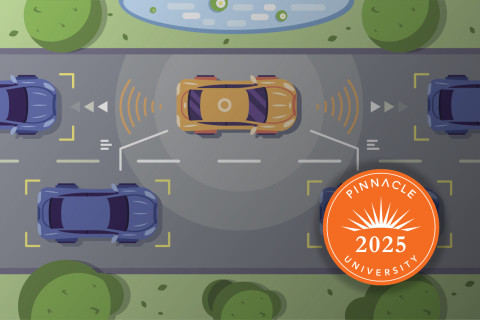
What's An Innovative Actuary to Do?
The success or failure of an insurance company, especially a captive insurance company, is all about uncertainty. A captive’s experience is impacted by variability in everything from differences in actual exposures (sales, payroll, miles driven) versus preliminary estimates to claims frequencies and severities. For some captives, the outcome of a single lawsuit verdict or a person’s living or dying can mean millions of dollars of additional loss payments.
For captives providing innovative coverages or serving emerging industries, the amount of variability is even more pronounced. More factors can impact claims experience and operating results. Examples include:
Data credibility – the degree to which an actuary can rely on historical data impacts the accuracy of their loss estimates. New industries or technologies can complicate this. How will the experience of last mile delivery companies, such as Amazon couriers, differ from other trucking programmes? How credible is the experience for these companies when there is only a year or two available?
Non-actuarial models – many captives insuring leading edge technology utilize statistical models and analyses developed by non-actuaries. This includes everything from medical diagnostic artificial intelligence (AI) systems to new safety controls in commercial trucks. How applicable are these models for use in actuarial model evaluating captive funding and feasibility?
Safety and loss prevention – many captives are based on new ways of doing things. New packaging or monitoring devices for packages in transit, new patient screening or education, physician apology rules, wearables for truck drivers and highrise construction crews, and new benefits in medical stop loss to improve wellness are just a few examples. How effective will these operational changes be at reducing claim frequency and/or severity?
Emerging industries or products – many new products and industries do not have readily available comparable industry benchmark data. What will the claims experience be for Tesla’s electric semi tractors? How about for their autonomous cars? What will the crop losses be for the hemp industry or for genetically modified produce? What will the loss experience be for workers in the gig economy (e.g. Task- Rabbit) or shared vehicles (e.g. Lime scooters or Zipcar cars)?
There is nothing more exciting for creative captive actuaries than innovation. Innovation is a tabula rasa for actuaries; space to design new insurance products or develop solutions for emerging markets. It is an opportunity to break new ground often with no established, textbook solutions.
However, this also increases the uncertainty within the actuary’s estimates, and therefore the risks to the captive’s viability. While it may sometimes seem there are no rules, it is long-established professional standards that help actuaries do their work on unfamiliar or uncommon ground. None more useful than the tried and true (and seemingly un-innovative) Actuarial Standards of Practice (ASOPs).
How ASOPs facilitate innovation
Naturally, ASOPs are essential to the fiscal health of companies, industries and economies. They engender trust in our profession and undergird the reliability and quality of actuarial work products. For established areas of practice, they are broadly utilized and deeply understood. But they are particularly useful in those instances where actuarial precedent is not as deep or perhaps even non-existent. They provide valuable guidance for captives in the gig economy, telematics, e-commerce and medical technology because actuaries use them to establish and foster credibility.
New data sources, methods, assumptions, and approaches to evaluating and quantifying risk depend on the structure and guidance provided by the ASOPs. The ASOPs also assist in ensuring that the pertinent information is well documented for captive owners, insureds, service providers, regulators, and other stakeholders.
Credibility is important for start-ups, nascent companies or companies in emerging industries. Trust in actuarial analyses, clarity in assumptions and confidence in financial statements can build investor and consumer trust. For organisations working to establish a future, that credibility and confidence are critical.
An example: actuaries facilitating innovation in medical technology In many areas of technological innovation, actuaries are by far in the minority among the myriad of data scientists, engineers and researchers. As a result, it is frequently the case that we are asked to rely on non-actuarial models as the source of the data in our analyses. As a result, one ASOP that continues to be increasingly important is ASOP No. 38, Using Models Outside the Actuary’s Area of Expertise (Property and Casualty).
A helpful illustration of how actuaries can apply ASOP 38 to facilitate innovation can be found in the medical technology industry. It is fast-moving, with frequent, revolutionary innovations in areas such as:
• Gene editing technology, like CRISPR;
• Nanotechnology used to fight cancer and facilitate organ transplants;
• Robotic surgery and blood draws using DaVinci robots and other devices; and,
• Artificial intelligence (AI) systems that provide more accurate readings of x-rays, MRI and CT scans and diagnoses and predictions of a wide variety of diseases.
Many of these remarkable technologies use insurance to provide performance guaranty, warranty, product liability, errors and omissions liability and other insurance coverages. A key goal of these insurance products is to increase the confidence that medical providers and patients have in the technology being deployed.
In the examples of new nanotechnology or AI systems, the development of a warranty or performance guaranty often relies heavily on non-actuarial models to develop premium pricing assumptions. Because these technologies are so fast-moving and changing, ASOP No. 38 is an invaluable tool for actuaries. ASOP No. 38 is a clear and distinct set of steps or guidelines to help actuaries understand if, when and how a non-actuarial model can be used. It states that an actuary should have understanding of the model, evaluate its appropriateness for the application as well as determinethat it is appropriately used.
Ultimately, this means the actuary must do much more than just blindly rely on the model without understanding its fundamentals. There are also requirements regarding the f documentation required in the actuarial report.
Consider an actuary who has been tasked with pricing a guarantee coverage for a new AI system that reviews x-rays in the diagnosis of potential lung cancer. The goal of the AI system is to reduce the number of false negatives, or the number of patients incorrectly told that they do not have lung cancer. These false negative readings can lead to delayed treatment, increased mortality risk, and misdiagnosis claims. To support the insurance pricing, the client provides a model showing the historical results of the AI system compared to human diagnoses for thousands of x-rays.
In this instance, the developers of the AI system and related parties provide research on its performance to the actuary. The source of the data, including any potential biases in the source data needs to be understood. If the research has been submitted for review or publication, this can help increase the efficacy of the results to the actuary. The actuary considers the source and, after making an assessment, needs to make a determination of the whether the model is appropriate for developing premium estimates and how it will be utilised.
The actuary must also document all of this in their actuarial report. This documentation is the goal of ASOP No. 38, and also ASOP No. 41. Exploring actuaries leave maps It’s impossible to overstate the utility of ASOP No. 41, Actuarial Communications. ASOP No. 41 sets out guidance on documentation, which is a fundamental step in complying with actuarial standards. At its core, the ASOP states “the actuary should state the actuarial findings, and identify the methods, procedures, assumptions, and data used by the actuary with sufficient clarity that another actuary qualified in the same practice area could make an objective appraisal of the reasonableness of the actuary’s work.” (ASOP No. 41, Section 3.2)
Another key section of ASOP No. 41, particularly in the context of captives and innovation, is Section 3.3, which includes guidance for documentation in specific or special circumstances. Innovation almost by definition includes special circumstances, often related to confidential or proprietary data. In addition, Section 3.4 provides direction related to documentation when there is material uncertainty or reliance on other sources.
Of course, several different ASOPs have relevance in other circumstances related to different, innovative products or coverages. But the key and central issue is that they must be used. Over the course of the coronavirus pandemic, the state of Illinois has been airing a really effective campaign encouraging people to wear masks. Using images of people wearing motorcycle and bicycle helmets, seat belts, life jackets and masks are followed by the message: “it only works if you wear it”.
Actuarial standards are like that; they only work if you use them. Actuarial standards give a tremendous amount of guidance to actuaries working with all manners of new coverages, industries and technologies. Worn (used) well by the actuary, they offer a great deal of protection for the actuarial soundness of the actuary’s work product and the captive insurance company’s operating results.
The usefulness of the actuarial standards is sustained and even increased, despite or because of, the ceaseless flow of new technologies, emerging industries and innovations that actuaries are working on. They help actuaries facilitate innovations. It is those ‘revolutionary actuaries’ and their work – particularly for captives and startups – that are enabling the future of medicine, transportation, commerce and yes, insurance.



